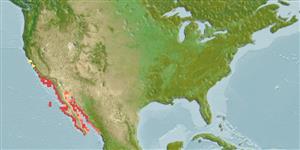Common names from other countries
Environment: milieu / climate zone / depth range / distribution range
экология
морской донно-пелагический; немигрирующий; пределы глубины 2 - 30 m (Ref. 9310), usually 2 - 6 m (Ref. 9310). Subtropical; 0°C - 33°C (Ref. 35682); 38°N - 23°N, 125°W - 106°W
Eastern Central Pacific: San Francisco in California, USA to southern Baja California, Mexico.
Size / Вес / Возраст
Maturity: Lm ? range ? - ? cm
Max length : 66.0 cm TL самец/пол неопределен; (Ref. 2850); наибольший возраст (опубликованны данные): 10 годы (Ref. 56049)
A resident intertidal species with homing behavior (Ref. 32612). Can leave tide pools if aquatic conditions become inhospitable (Ref. 31184). Also found near or over rocks and in kelp beds up to about 30 m depth. Feed mainly on seaweed, occasionally takes invertebrates. Form dense schools in spring in kelp beds. Pelagic spawner (Ref. 56049). Breathe air when out of water (Ref. 31184). Considered an important game fish and may incidentally be caught in commercial fishing activities (Ref. 9310). Marketed fresh (Ref. 9310).
Life cycle and mating behavior
Maturities | размножение | Spawnings | Egg(s) | Fecundities | личинки
Pelagic spawner (Ref. 56049).
Eschmeyer, W.N., E.S. Herald and H. Hammann, 1983. A field guide to Pacific coast fishes of North America. Boston (MA, USA): Houghton Mifflin Company. xii+336 p. (Ref. 2850)
Статус Красного Списка МСОП (Ref. 130435)
CITES (Ref. 128078)
Not Evaluated
Угроза для людей
Harmless
Использование человеком
рыболовство: коммерческий; объект спортивного рыболовства: да
дополнительная информация
инструменты
Специальные отчеты
Скачать в формате XML
ресурсы в Интернет
Estimates based on models
Preferred temperature (Ref.
115969): 15.4 - 24.2, mean 22.3 (based on 112 cells).
Phylogenetic diversity index (Ref.
82804): PD
50 = 0.5000 [Uniqueness, from 0.5 = low to 2.0 = high].
Bayesian length-weight: a=0.01698 (0.00949 - 0.03040), b=3.15 (2.99 - 3.31), in cm Total Length, based on LWR estimates for this species & (Sub)family-body (Ref.
93245).
Trophic level (Ref.
69278): 2.0 ±0.00 se; based on food items.
устойчивость к внешним воздействиям (Ref.
120179): средний (среднего размера), минимальное время удвоения популяции 1.4-4.4 года (tm=2.5; tmax=10).
Fishing Vulnerability (Ref.
59153): Moderate to high vulnerability (46 of 100).
Climate Vulnerability (Ref.
125649): High to very high vulnerability (70 of 100).
